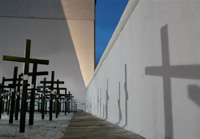 |
|
Crosses form shadows on a replica of
the Berlin Wall in Berlin, Sunday, Nov. 7, 2004. 1,065 crosses
commemorate those who died while trying to escape from East
Germany. Tuesday, Nov. 9, 2004 is the 15th anniversary of the
night the Wall fell in 1989.
(AP) | |
Ceremonies to mark the 15th anniversary of the
fall of the Berlin Wall was held in the German capital on Nov. 9th.
The city's mayor laid a wreath, while the chancellor when the wall
fell, Helmut Kohl, took part in a public debate.
The barrier was constructed by the East German authorities in 1961, in
response to the growing numbers of citizens fleeing into West Berlin.
Fifteen years on, memories are dimming of a cold November night when
the impossible happened.
East Berliners were suddenly free to cross into the West - and they did
so in their thousands.
For decades the Berlin Wall was the most tangible symbol of the Cold War.
In the Soviet Union the leader at the time, Mikhail Gorbachev, was
pursuing Glasnost, or ‘openness'. The hardline leadership in East Berlin
was powerless to stop the first mass demonstrations in decades.
Opening the wall was a moment of history that finally led to German
re-unification.
But it is an uneasy unity today, with the former east still lagging
behind the west economically, despite receiving huge subsidies over the
last 15 years.
The situation is causing
simmering resentment in both halves of Germany.
(Agencies) |
11月9日,纪念柏林墙倒塌15周年的仪式在德国首都举行。
柏林市长(在柏林墙前)献上了花环,柏林墙倒塌时在位的前联邦德国总理赫尔穆特·科尔参加了公开讨论。
1961年,由于逃往西柏林的人数不断增加,当时的东德当局修建了柏林墙作为应对措施。
15年过去了,关于15年前那个11月的寒冷夜晚的记忆已渐渐模糊。但就在那个晚上,不可思议的事真的发生了。
东柏林的居民突然可以自由地穿过(柏林墙)去往西柏林,数以千计的人们也确实这样做了。
几十年来,柏林墙一直是冷战最真实的象征。
当时的前苏联领导人米哈伊尔·戈尔巴乔夫倡导“开放”的政治改革。当时东德领导人奉行的强硬路线已经无力阻挡几十年来的第一次大规模示威活动。
柏林墙的开放是历史性的一刻,最终促成了德国统一。
但是如今,统一后的德国并非天下太平。尽管在过去15年间,原东德地区获得了巨额补贴,但在经济上,它仍然落后于原西德地区。
这种情形导致了原东西德双方间的埋怨和不满逐渐增加。
(中国日报网站译) |
